Taste the Terroir of the tea-producing region Makinohara at Daichi no Chanoma【Makinohara City, Shizuoka Prefecture】
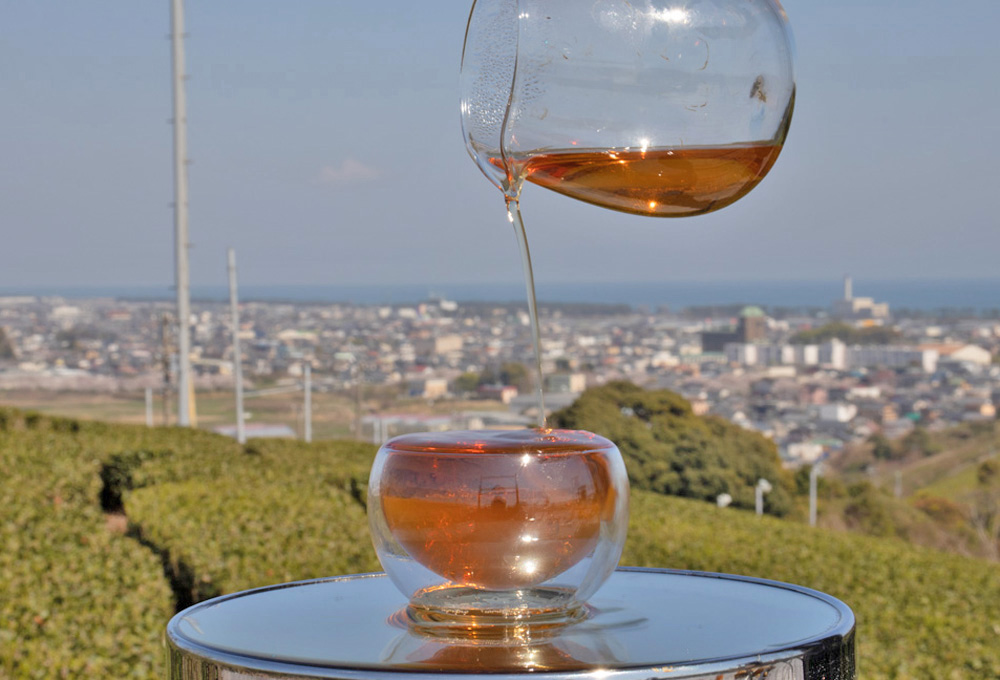
Shizuoka is the number one tea producing region in Japan. Located in the centre, Makinohara, one of the prefecture’s leading tea production areas, is home to an expanse of tea fields spread over a vast plateau at an elevation of around 100m. To preserve the amazing views and cultural heritage of this area, the Suruga Tourism Bureau, promoting tourism in the central region of Shizuoka Prefecture, has begun renting out private terraces in the middle of tea plantations, called Chanoma in 2019. The open-air terrace overlooking the tea fields in all directions will offer relaxing moments and aromatic Japanese tea directly from the growers. These “Chanoma” attract visitors from all over the world and has been featured in numerous media outlets as a great place to enjoy authentic Shizuoka tea. As of May 2023, there are six “Chanoma” in the prefecture. This time, we visited “Daichi no Chanoma” in Makinohara City. We were welcomed by Toshifumi Shibamoto, the owner of Daichi no Chanoma and also the owner of Kamairicha Shibamoto.
This article is a full-length interview with Toshifumi Shibamoto, explaining the services available at Daichi no Chanoma and terroir of the locally produced teas at Kamairicha Shibamoto.
Contents
- 1 About Daichi no Chanoma
- 2 A Tea Terrace in an exhilarating location befitting the name ‘Daichi’ or in other words ‘Vast Land’.
- 3 A relaxing moment spent in the “Daichi no Chanoma” with fragrant kamairicha as an accompaniment
- 4 The ‘taste of the terroir’ that the owner of Daichi no Chanoma, Shibamoto aims for
- 5 We intend to deliver teas made with utmost care through our expressions of originality and ingenuity.
- 6 An art piece created by great natural forces. The time-line of a tea plantation returning to nature.
- 7 Information of Daichi no Chanoma
About Daichi no Chanoma
Daichi no Chanoma is a private terrace set up in a tea garden managed by Kamairicha Shibamoto. The terrace is located on the top of a small hill, surrounded with views of Mt. Fuji, the Minami Alps, Suruga Bay and the Izu Peninsula. Visitors can enjoy an exhilarating panorama extending all the way to the horizon. For a moment of relaxation, fragrant Japanese tea is served directly from the producer.
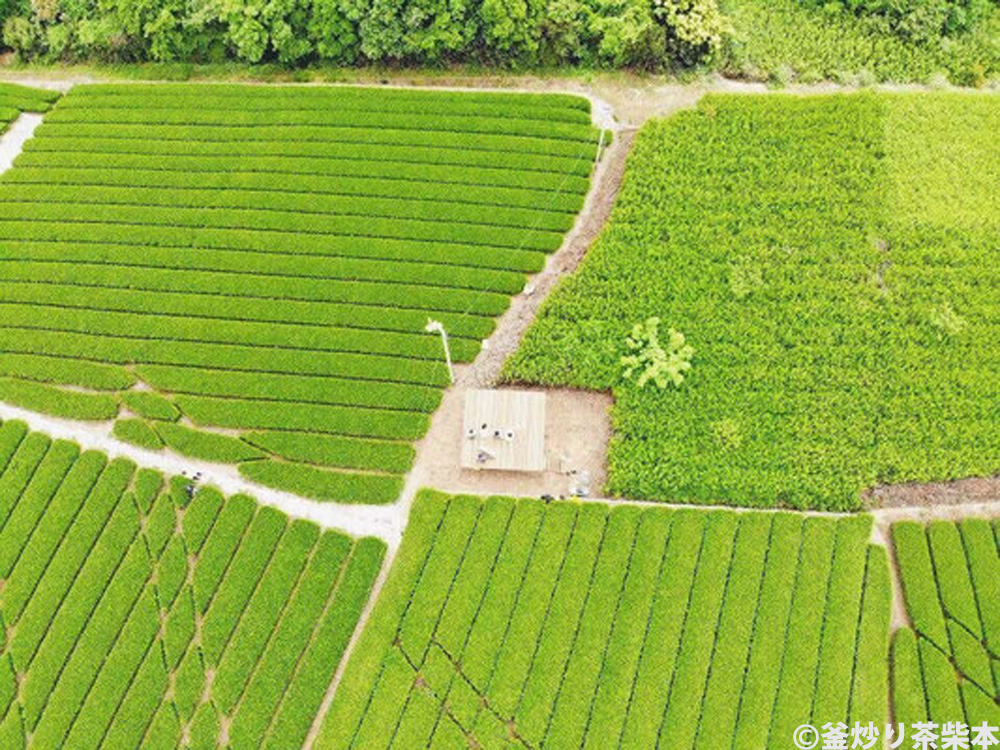
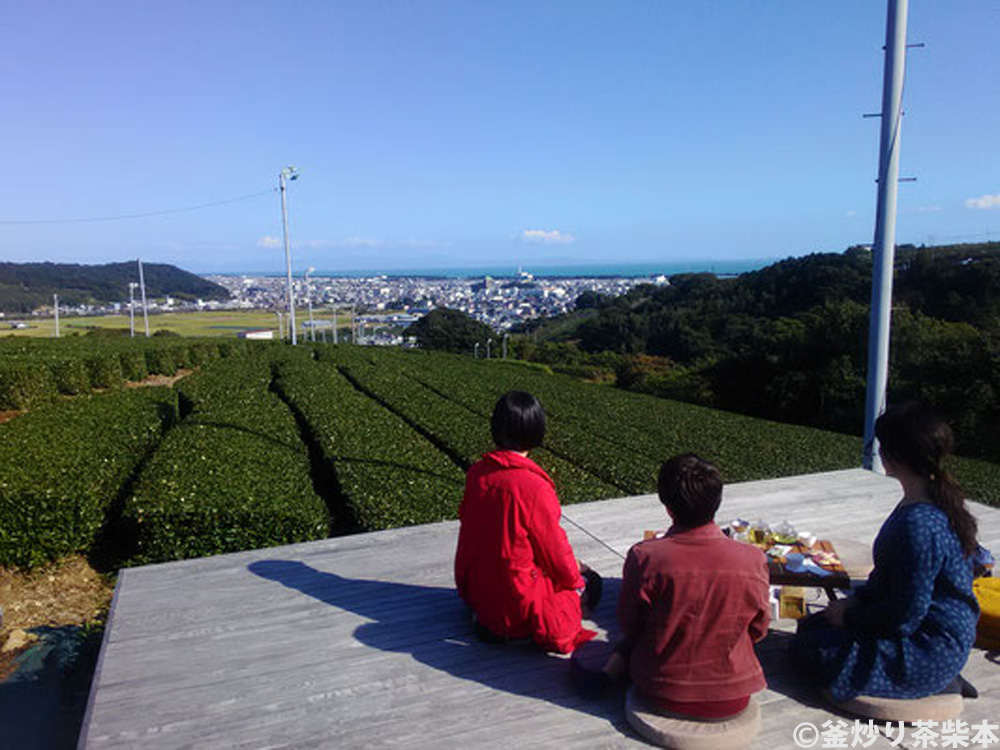 ▲”Daichi no Chanoma” is made of eucalyptus wood. Weather permitting, visitors can enjoy views from Suruga Bay to Mt. Fuji.
▲”Daichi no Chanoma” is made of eucalyptus wood. Weather permitting, visitors can enjoy views from Suruga Bay to Mt. Fuji.
A guide to the use of Daichi no Chanoma
Reservations must be made in advance for the “Daichi no Chanoma” through the “Chanoma” website. On the day of the tour, after completing the registration at the reception, you will be accompanied by the owner, Mr. Shibamoto.
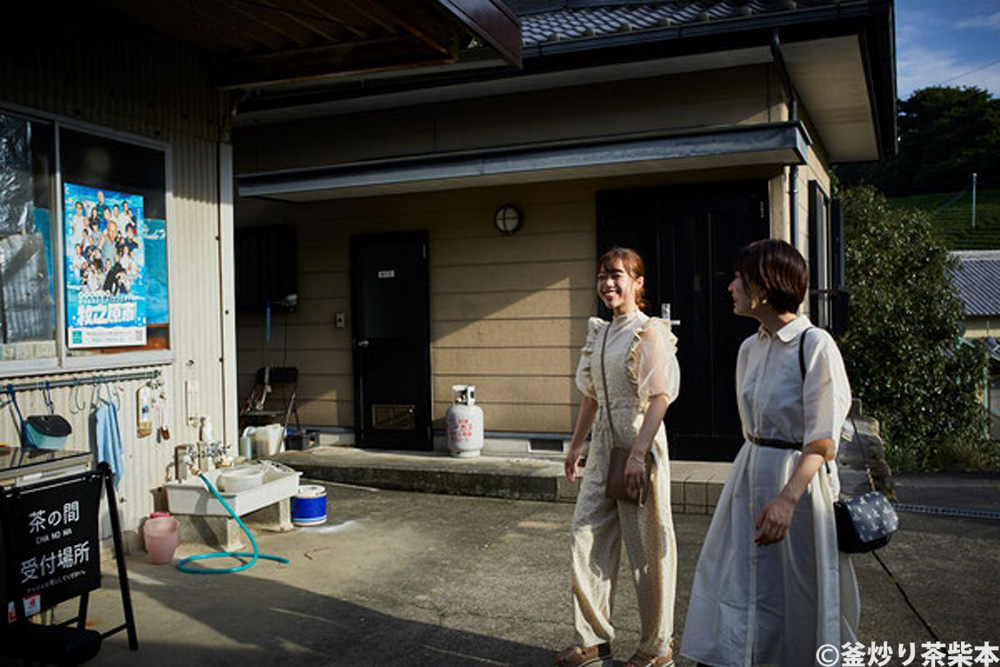
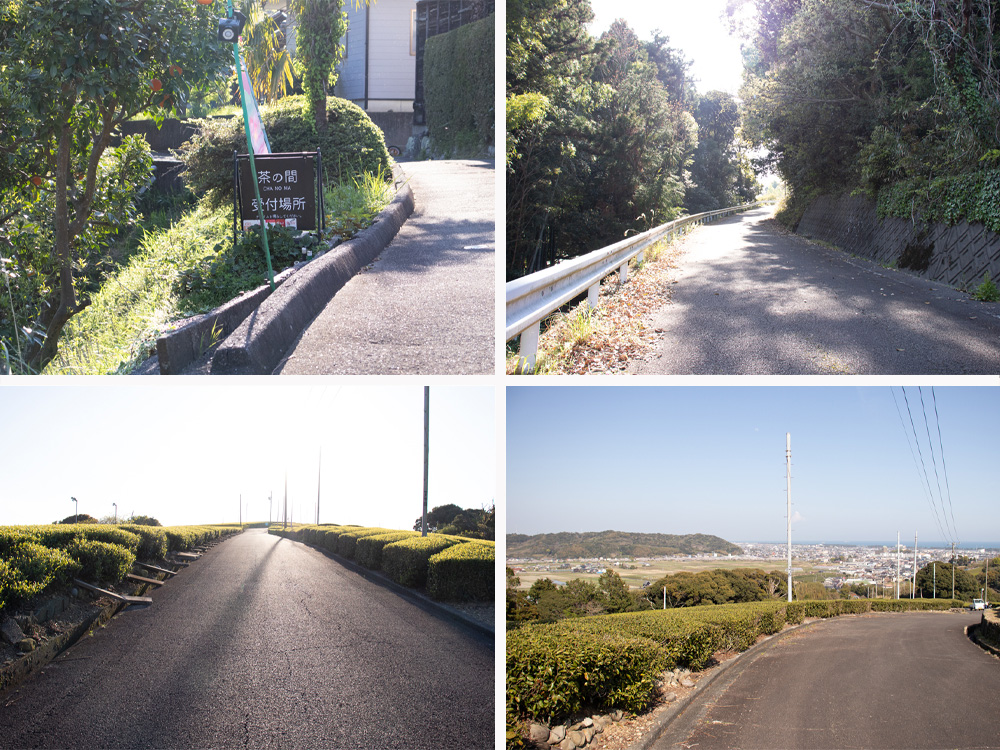 ▲The gentle slope on the way to the Chanoma. Toshifumi Shibamoto says, “If I start sweating on the walk here, I know it’s almost summertime.”
▲The gentle slope on the way to the Chanoma. Toshifumi Shibamoto says, “If I start sweating on the walk here, I know it’s almost summertime.”
A Tea Terrace in an exhilarating location befitting the name ‘Daichi’ or in other words ‘Vast Land’.
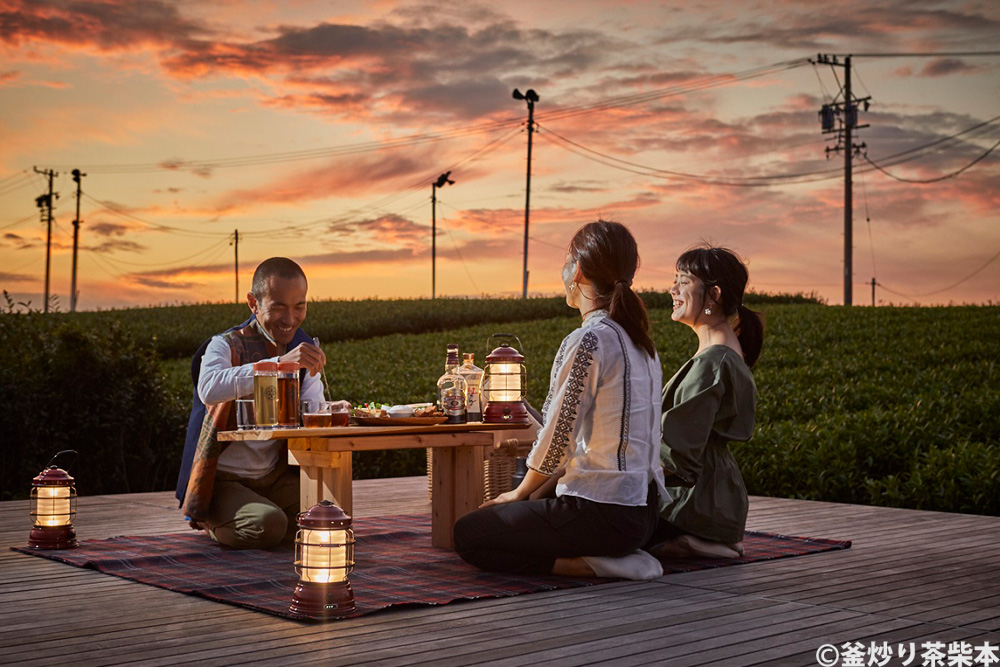
We interviewed Toshifumi Shibamoto, the owner of Daichi no Chanoma and the head farmer of Kamairicha Shibamoto.
–This is Daichi no Chanoma! What an invigorating location. I can see all the way to the horizon!
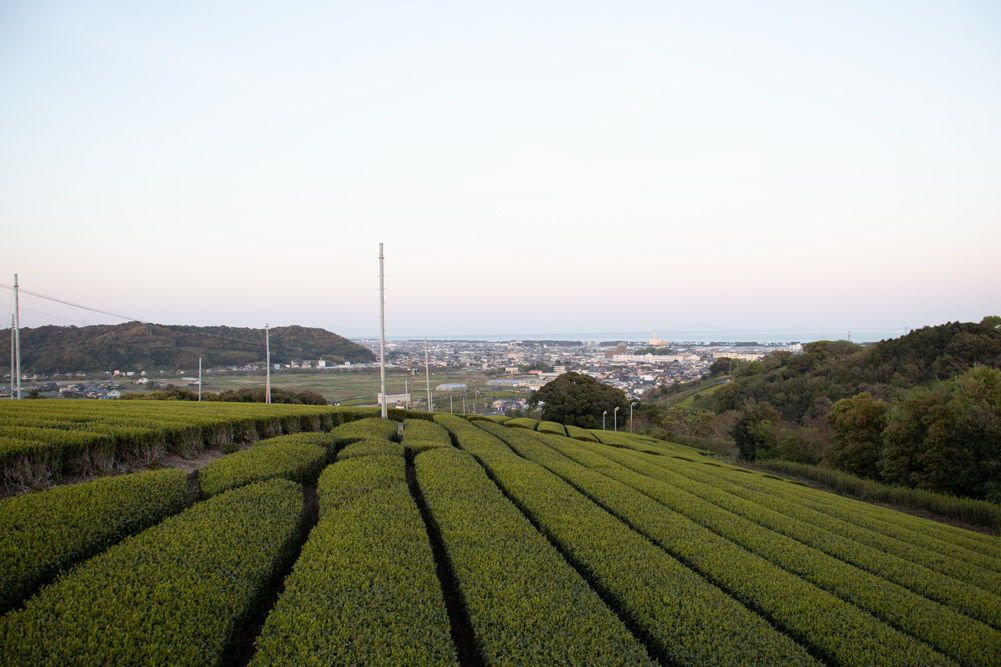
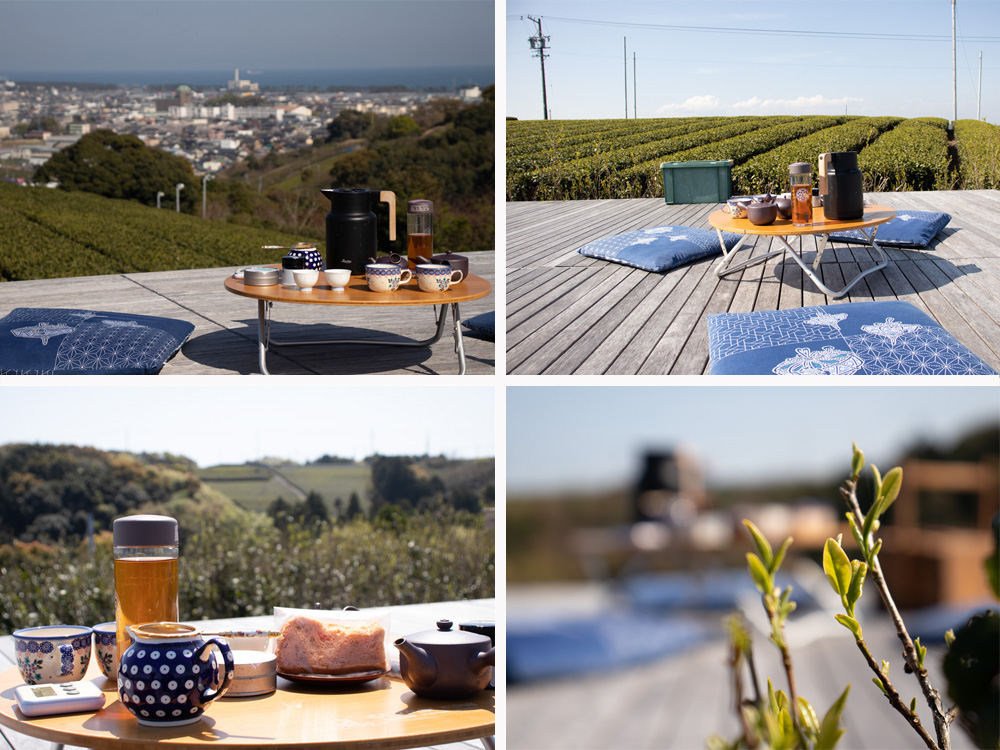
I thought it would be nice to have a spot with a panoramic view all the way to the horizon, befitting the name “Daichi.” On a clear day one can see Mt. Fuji and the Izu Peninsula from here. At dusk, the bright red sunset over the tea garden is fantastic as well.
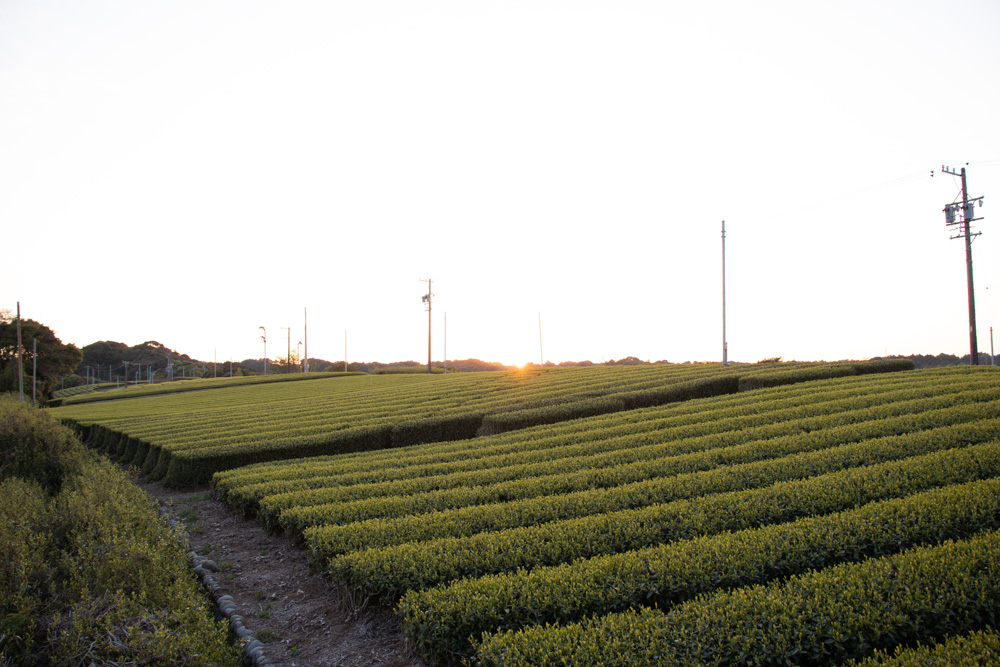
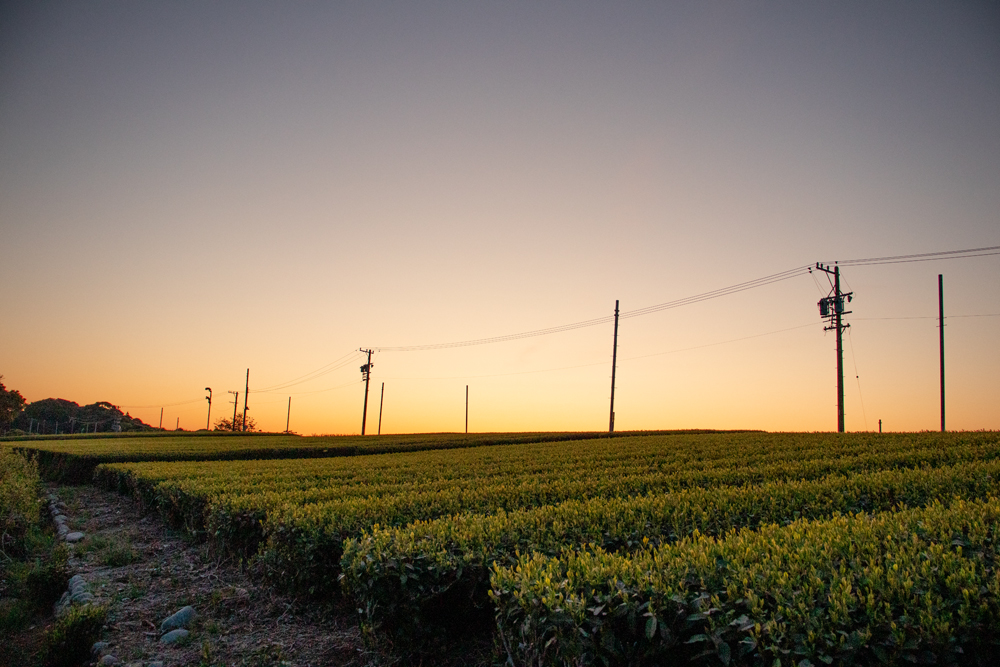 ▲The tea farm dyed in sunset colors photographed from Daichi no Chanoma.
▲The tea farm dyed in sunset colors photographed from Daichi no Chanoma.
Most people may have been exposed to tea itself, but not many have had the opportunity to be acquainted with a tea plantation. That is why we decided to create a private tea terrace, “Chanoma,” where people can enjoy tea surrounded by majestic nature. We have prepared a variety of ways to enjoy our tea regardless of age, gender or background.
Once the “Chanoma” experience is over, you are free to leave your tea sets here. Enjoy the picnic atmosphere on the way and return home feeling light and refreshed.
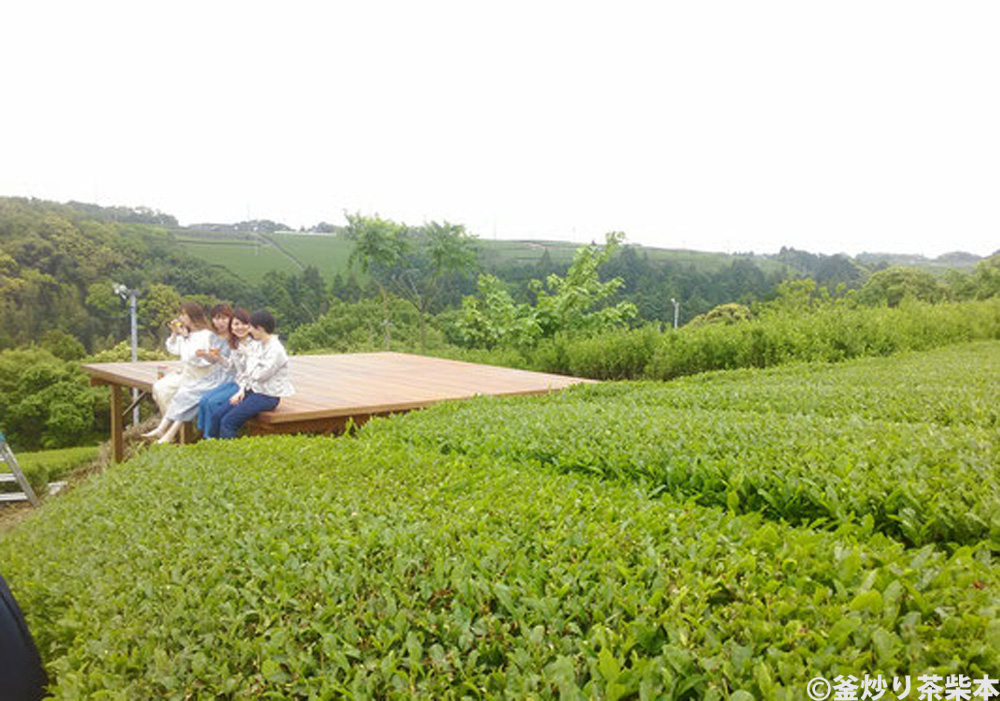 ▲The exhilarating location provides a therapeutic moment, even for those who are not interested in tea.
▲The exhilarating location provides a therapeutic moment, even for those who are not interested in tea.
A relaxing moment spent in the “Daichi no Chanoma” with fragrant kamairicha as an accompaniment
To compliment the relaxing moments spent here, we offer fresh tea directly from our farm.
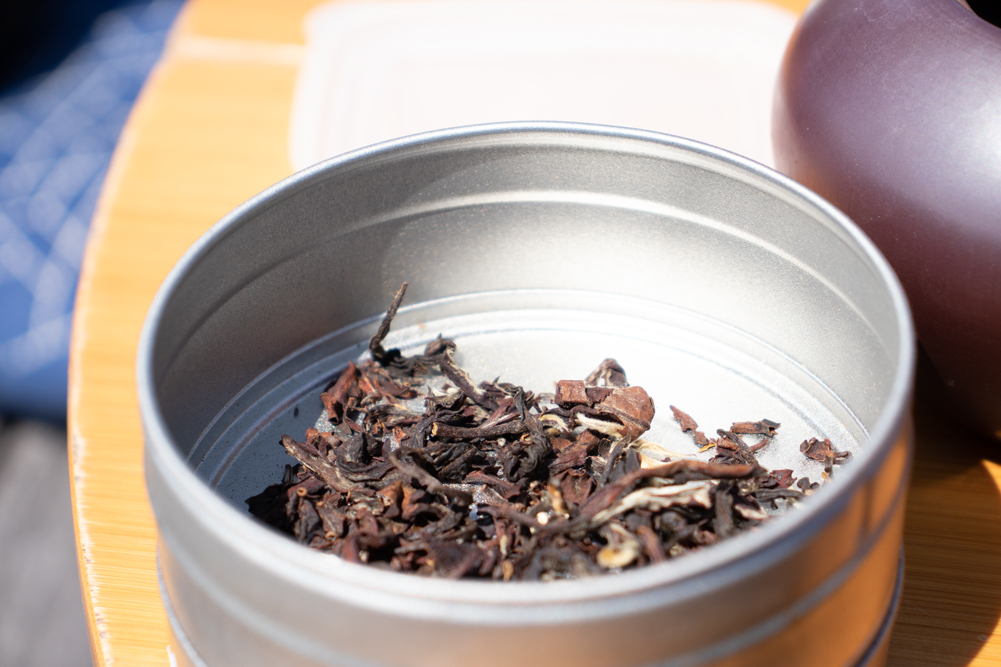
In generally most of the teas offered to the public are steamed green teas called sencha, but the tea I make is made by roasting the leaves at a high-temperature in a round kettle, called kamairicha (kettle-roasted tea). It is mainly produced in Miyazaki, in Kyushu, and is very rare, accounting for less than 1% of the total tea production in Japan. It is sometimes called ‘guricha’ because of the appearance of the tea leaves, which are shaped like magatama beads.
(*It is hard to find a place in Shizuoka Prefecture that stocks kamairicha. The other place is San Grams – Green Tea & Garden Cafe, in Kikugawa, that also offer kamairicha produced by Gokase Green Tea industry in Miyazaki.)
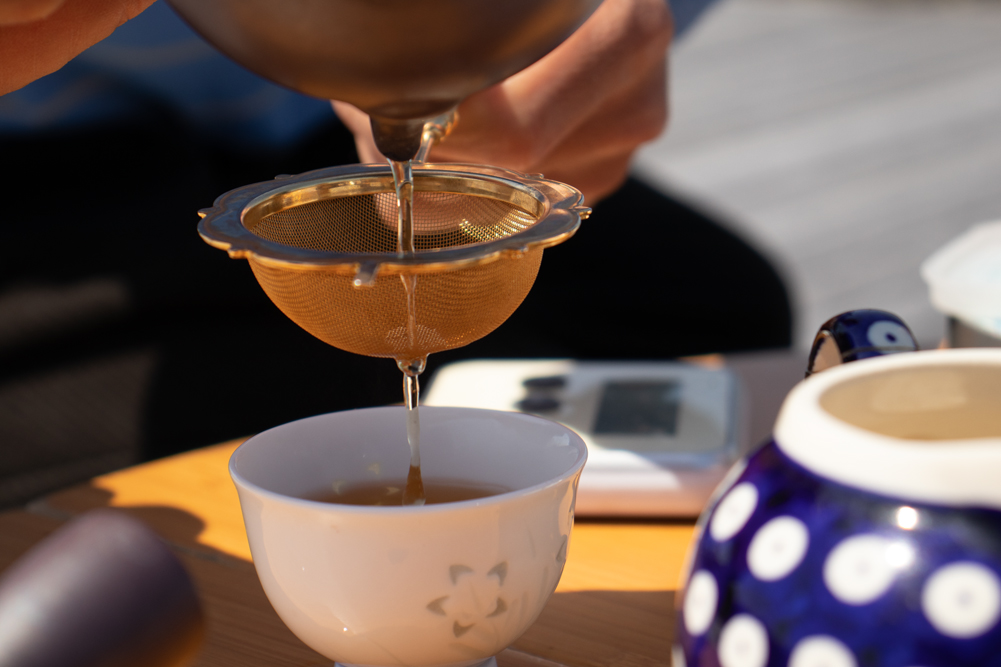
–It has a wonderful aroma and is extremely easy to drink. It is almost as if it seeps gently into the body. I think “spotlessly clear” is the perfect word to describe this tea.
That clear aroma is the characteristic that I aim for, “a tea that allows one to taste our terroir.”
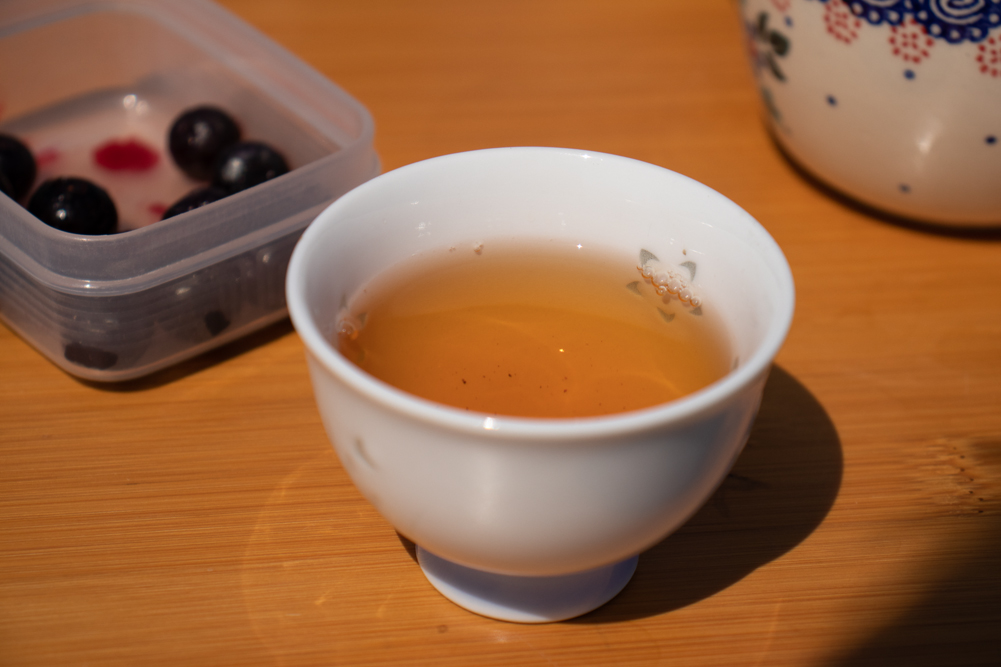
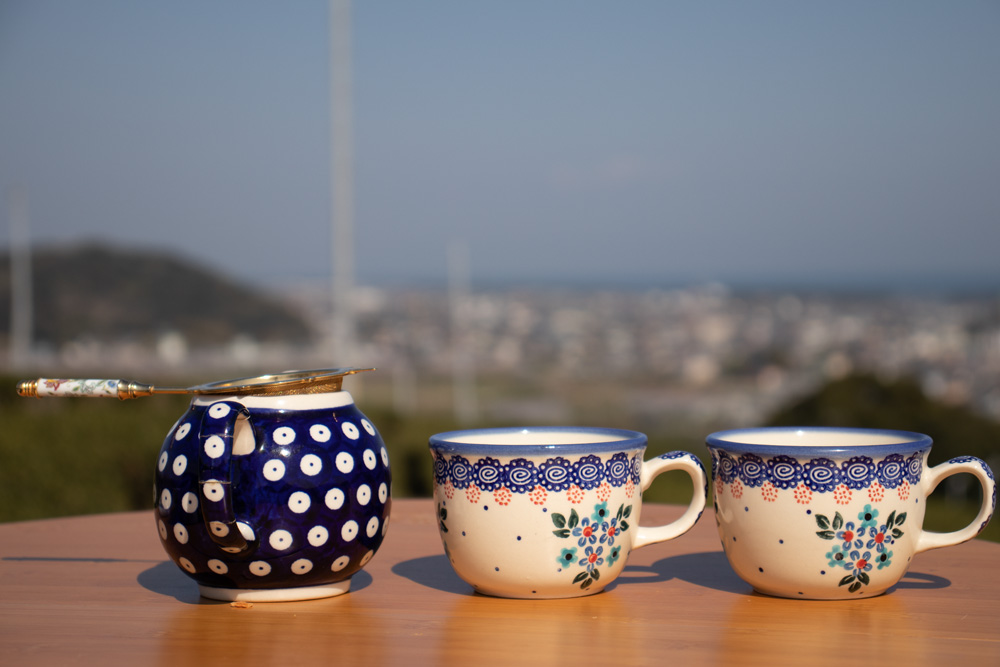 ▲Tea utensils made in Poland are also available for rent during your experience at Daichi no Chanoma. Kamairicha Shibamoto’s tea is also exported to Poland.
▲Tea utensils made in Poland are also available for rent during your experience at Daichi no Chanoma. Kamairicha Shibamoto’s tea is also exported to Poland.
–When you say terroir, do you mean the natural flavors born of the local climate and environment?
Yes, we do. We make teas that are full of the flavor of the minerals and nutrients naturally occuring in the earth. Therefore, our philosophy is not to apply any fertilizers or pesticides to our tea plants.
 ▲Because we don’t use fertilizers, we can proudly say that our tea is the pure flavor of the land. ‘The taste of the terroir’ is the philosophy we uphold in Kamairicha Shibamoto’s teas.
▲Because we don’t use fertilizers, we can proudly say that our tea is the pure flavor of the land. ‘The taste of the terroir’ is the philosophy we uphold in Kamairicha Shibamoto’s teas.
The ‘taste of the terroir’ that the owner of Daichi no Chanoma, Shibamoto aims for
–So you don’t use fertilizers on your tea. Does the crop not change year by year?
You’re right, if we wanted to produce the same crop year after year, we would need to make some ecological adjustments. In addition to fertilizing, tea plantation managers must make various adjustments, such as pruning and harvesting at the right time, in order to achieve the aroma that they envision.
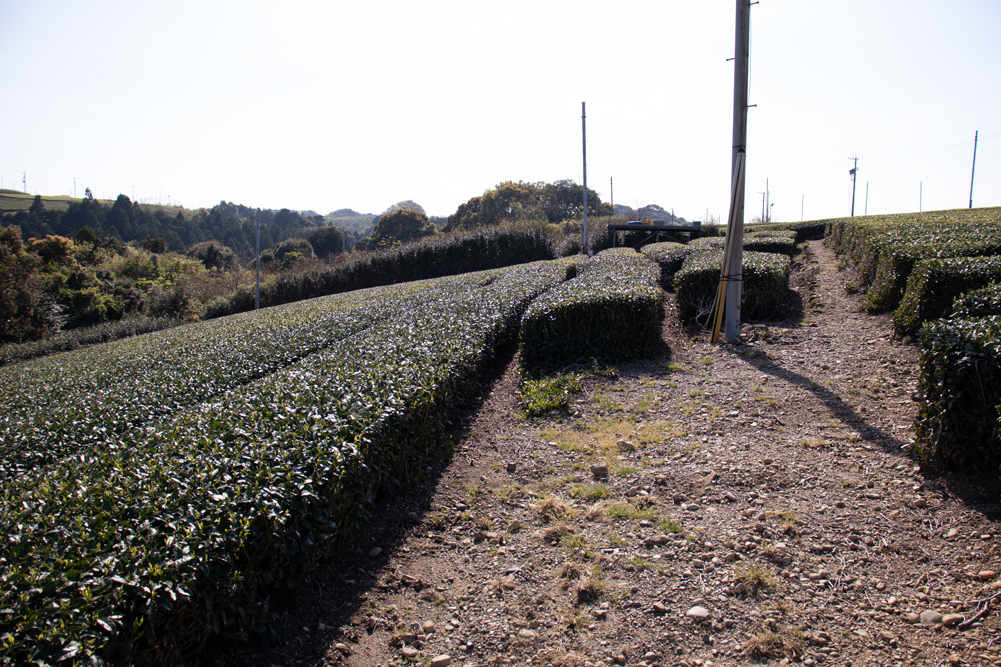
In our case, we try to let the tea plants grow freely. I closely observe how the tea plants are growing and take appropriate measures. Simply put, I take a passive attitude toward the tea plants.
 ▲Shibamoto is currently preparing a field of the cultivar, “Inzatsu.”
▲Shibamoto is currently preparing a field of the cultivar, “Inzatsu.”
–So you adjust your farming and tea-making methods according to the way the ecosystem is behaving?
Yes. I have mastered numerous production methods of a wide variety of cultivars, so I can choose the techniques that best suit the tea plants’ biorhythms, which are different year to year. In this way, I can refine the final product to the flavor I envision.
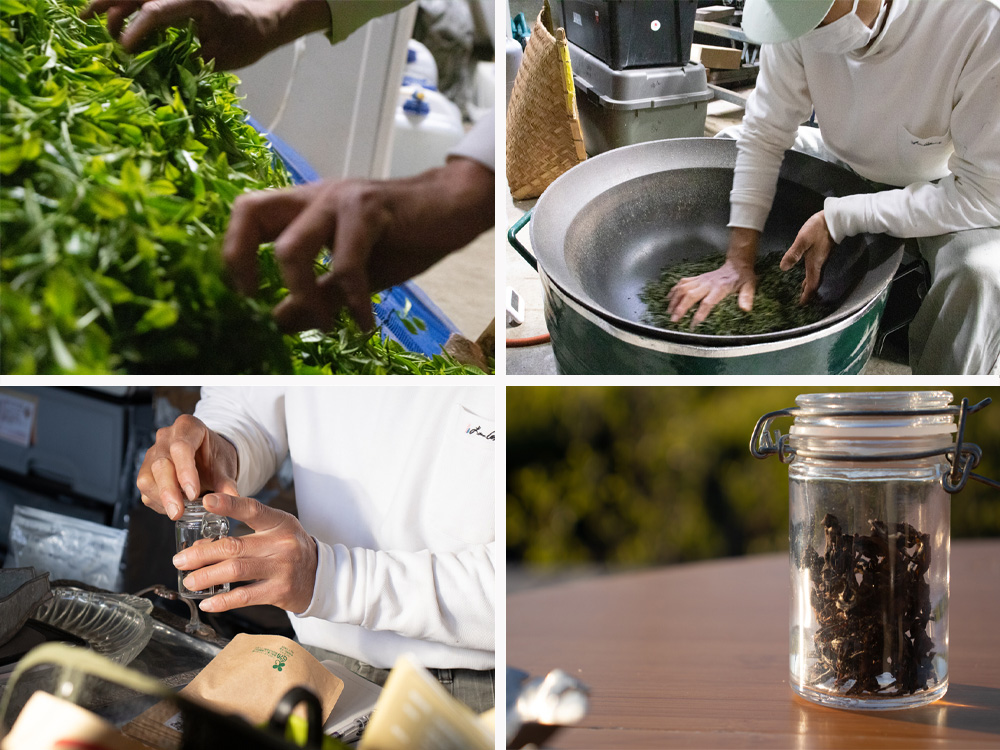
–I see, in the same way a top chef can make the best use of his ingredients.
As with anything, the important thing is preparation and setup. If you have decided on the kind of tea you want to make, the tea making process has already begun with the design of the plantation. When I design a tea garden, I put the surrounding plants and trees, wind paths, sunlight exposure, and soil environment, into my calculations to create the optimal growing environment for the tea plants. On this basis, neither pesticides nor fertilizers are required.
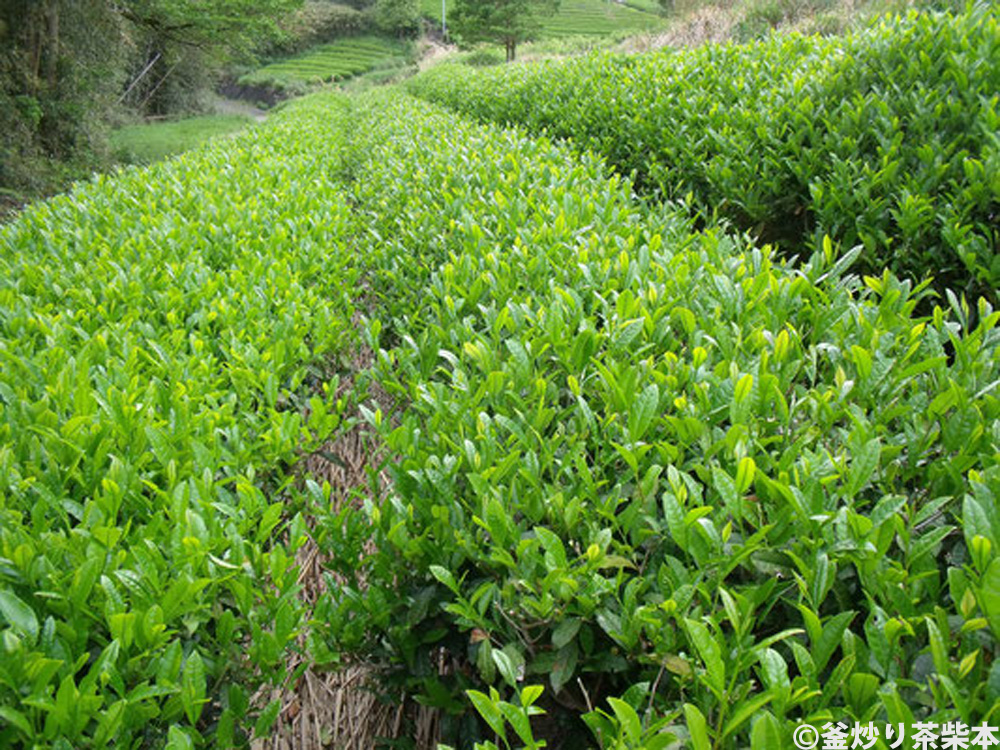
In this way, the tea plants adapt to the ecosystem in which they live together with the other plants and trees. This is what I aim for in my tea production, to be sustainable and in harmony with the local nature. Ideally, I would like to use firewood instead of electricity or gas so that our production cycle can be completed entirely with the resources available in the area.
(*A sustainable agricultural system with a small environmental impact, in which agriculture is carried out within the bounds of its surrounding ecosystem, including human beings, is called circular agriculture. More information about circular agriculture in another article on Taruwakien ,too).
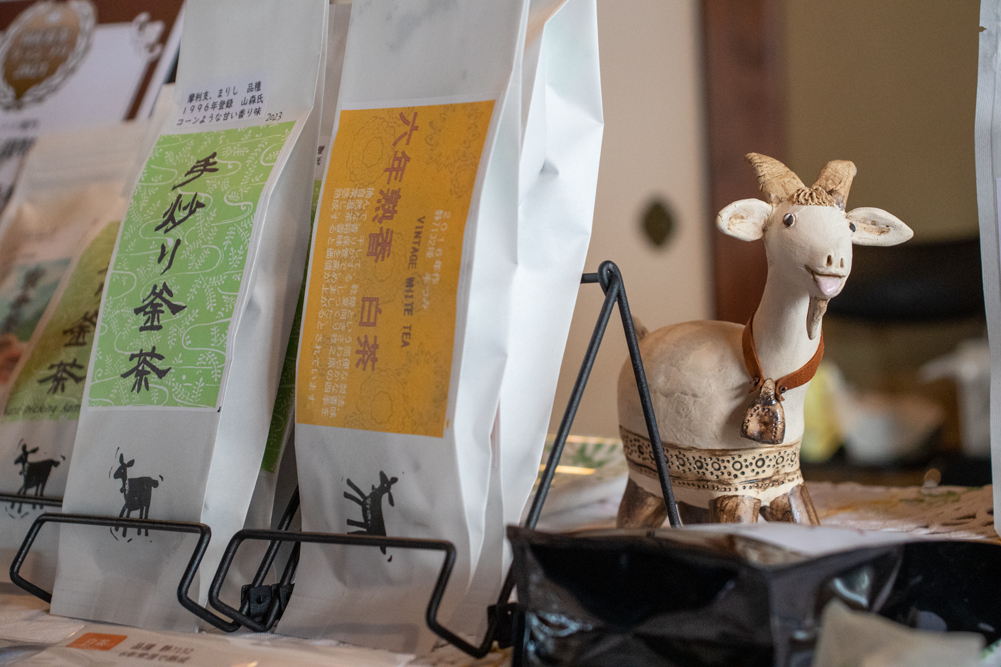
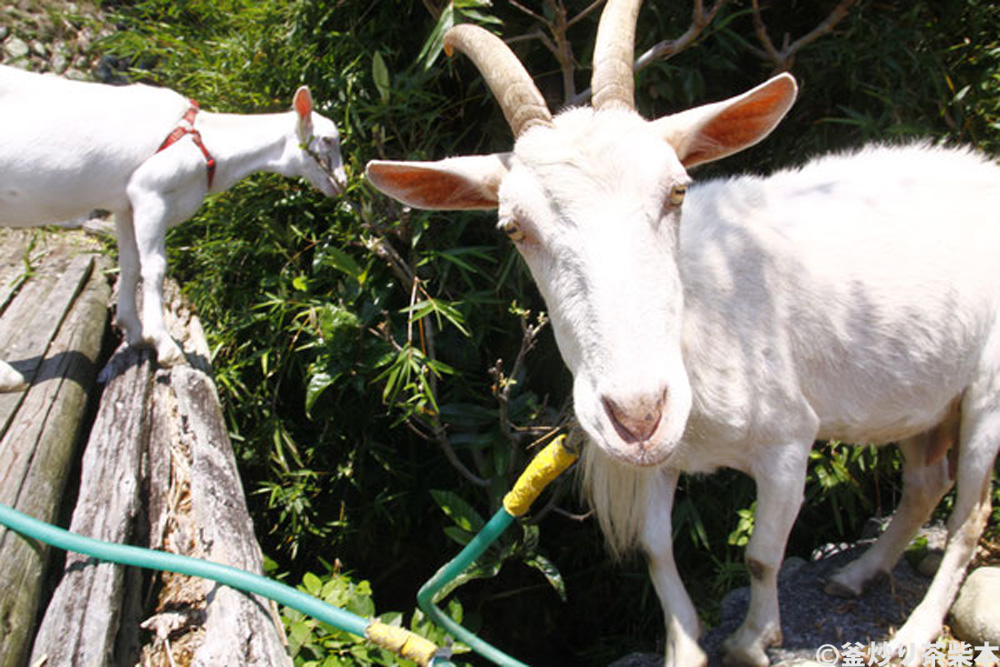 ▲With the motto “Be friends with weeds and insects and grow tea sustainably in harmony with nature,” we keep goats to eat the weeds around the farm and use their manure to make compost to cultivate the tea.
▲With the motto “Be friends with weeds and insects and grow tea sustainably in harmony with nature,” we keep goats to eat the weeds around the farm and use their manure to make compost to cultivate the tea.
However, this farming method is not suitable for mass production, and so sales prices are on the high side. It would be difficult to say that there is a demand for luxury tea within the Prefecture.
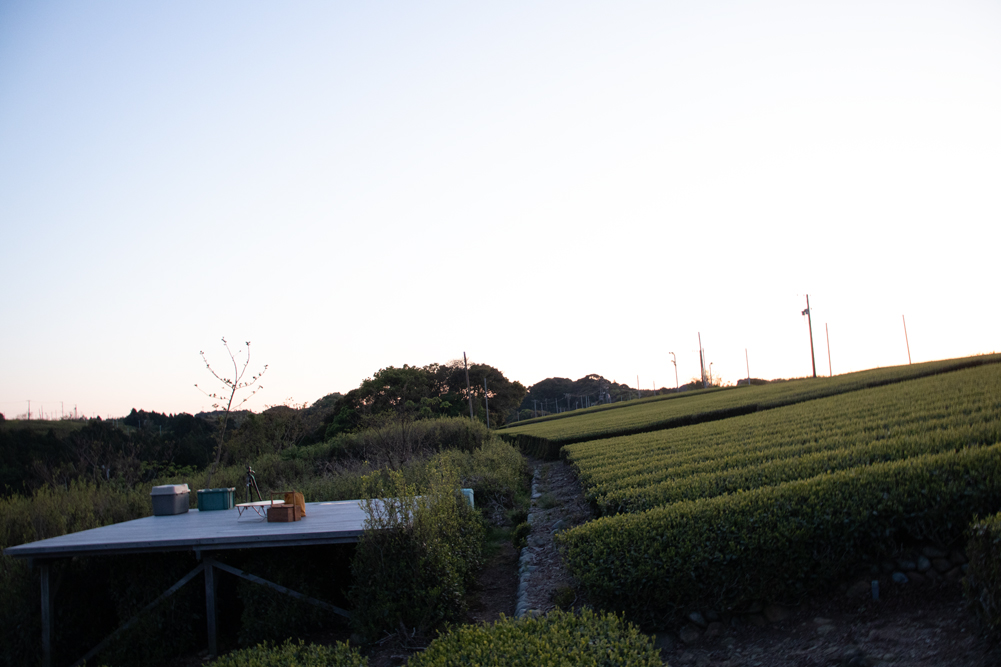
Therefore, it is necessary not only to make delicious tea with great care, but also to deliver the tea to our customers. I am as committed to expressing and promoting tea through various forms as I am to making tea myself.
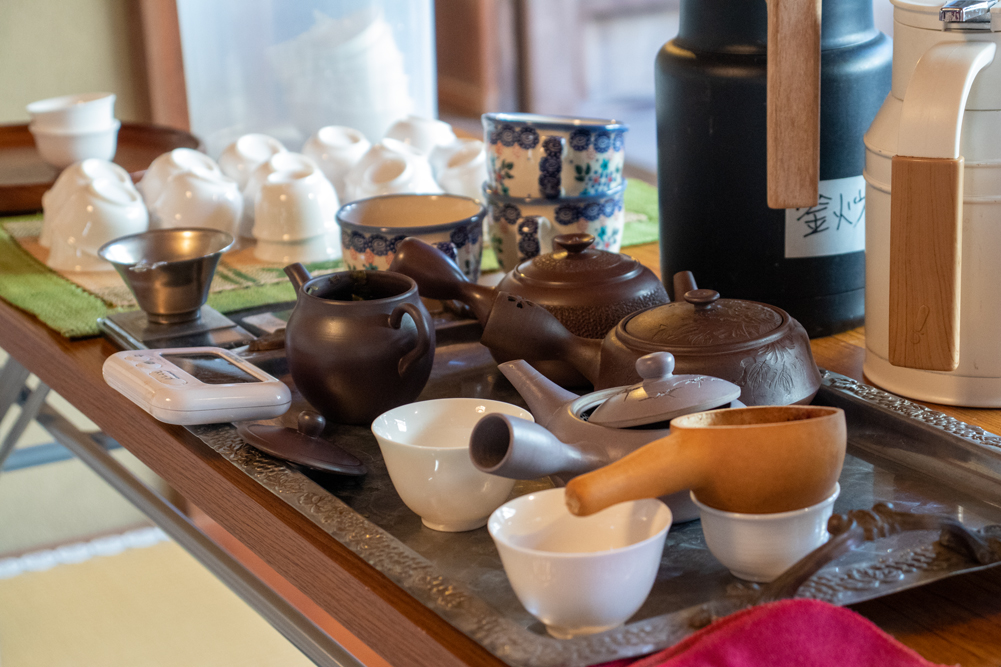
We intend to deliver teas made with utmost care through our expressions of originality and ingenuity.
While of course it is of great importance to make delicious tea, we believe that there is also value in experiencing the process of transforming a plant into a beverage through tea.
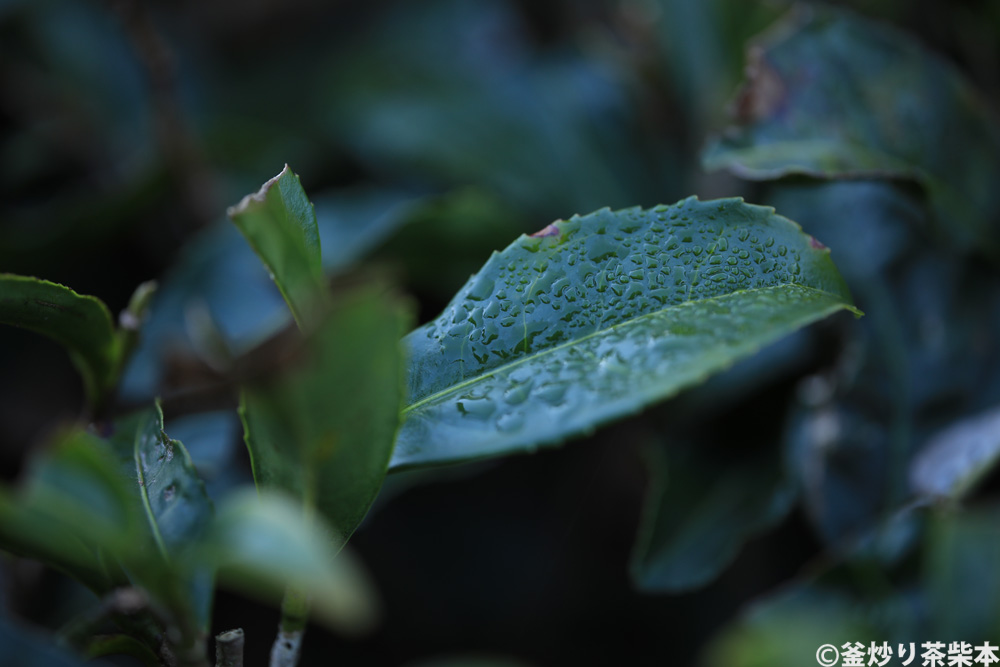
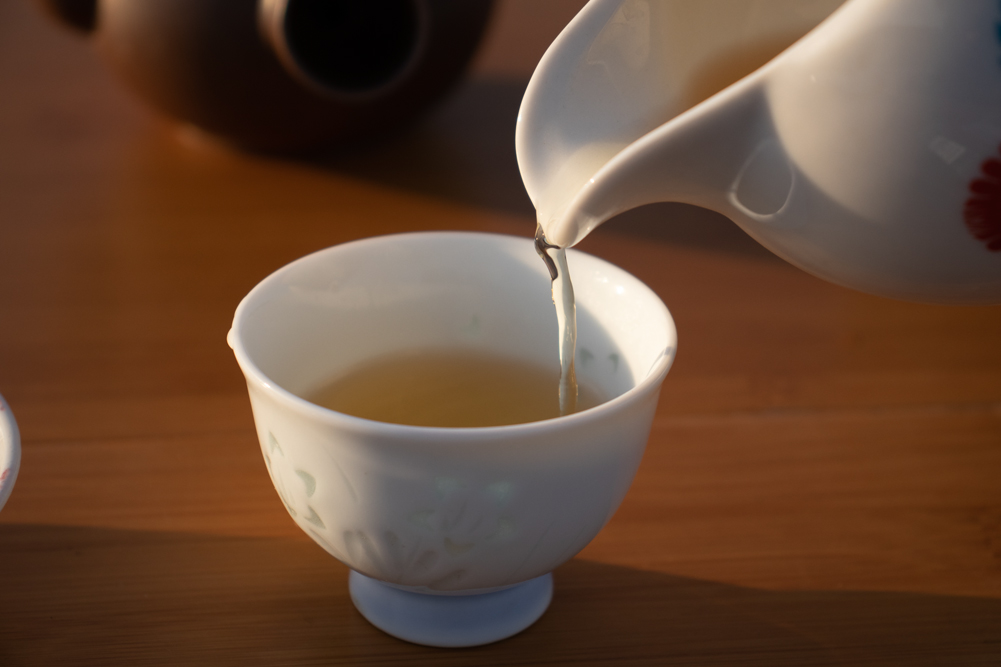
That is why at Daichi no Chanoma we also offer an hands on experience of making kamairicha. Guests will be given a basket in which they put leaves they freely hand-pick from the surrounding tea plantation. At the specified time, guests will join me in the hut to make kamairicha.
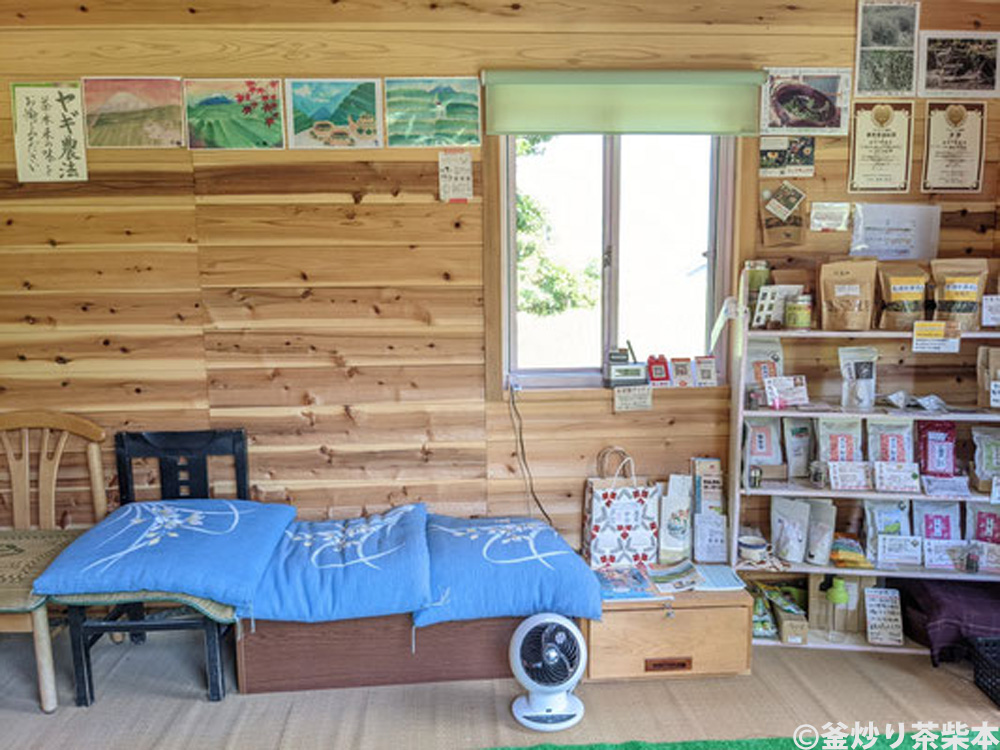 ▲A kettle roasting experience on a loft in a small cabin. ▼ Larger parties enjoy the experience held in a large warehouse as shown below.
▲A kettle roasting experience on a loft in a small cabin. ▼ Larger parties enjoy the experience held in a large warehouse as shown below.
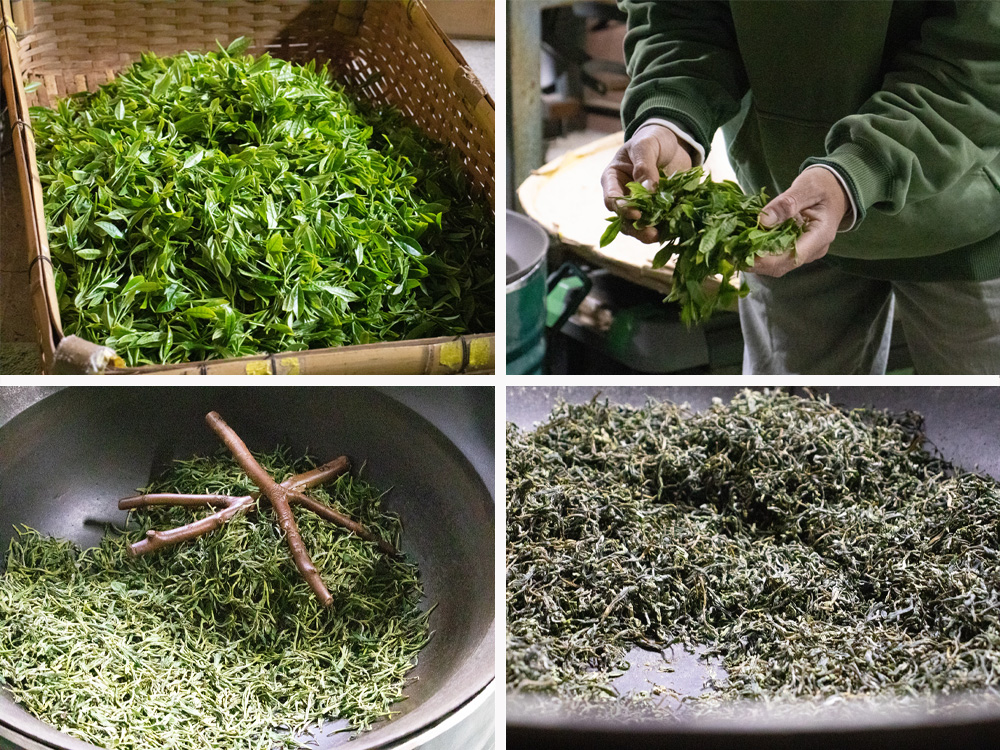
We are also working on other programs that enable visitors to experience through all five senses the process of how harvested raw materials are transformed by roasting. We intend to provide a number of intriguing experiences that will appeal both to Japanese and non-Japanese visitors.
–You really have done your research and thought of all kinds of interesting workshops haven’t you!
Recently, we have been actively organizing more elaborate events, and our activities are becoming more and more artistic. It is actually a lot of fun to do so. Lately I think I am more suited to being an artist who promotes Japanese tea through various forms of expression rather than a tea farmer (laughs).
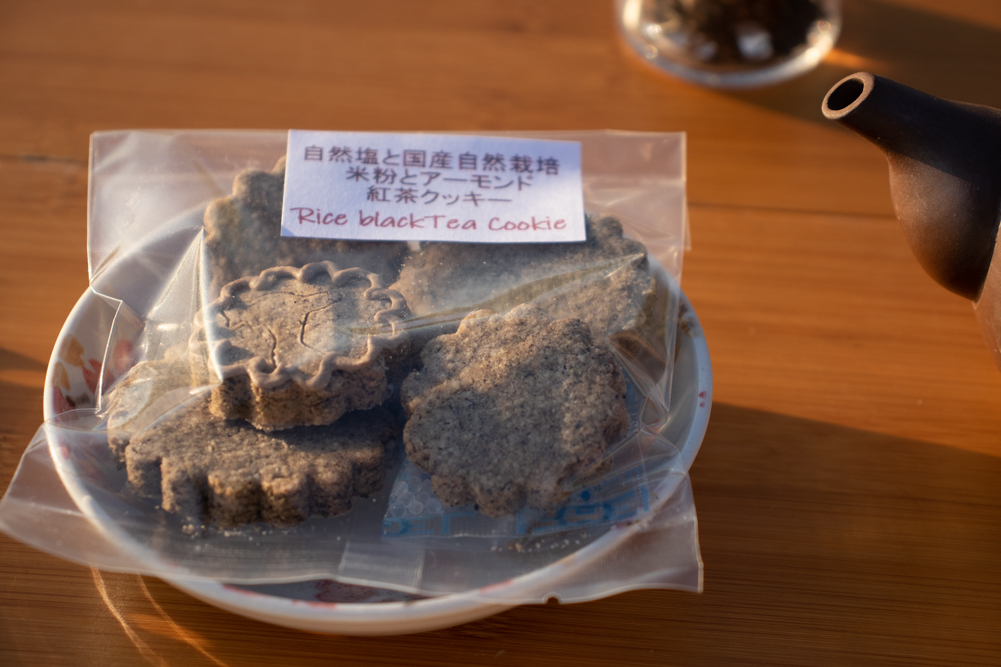
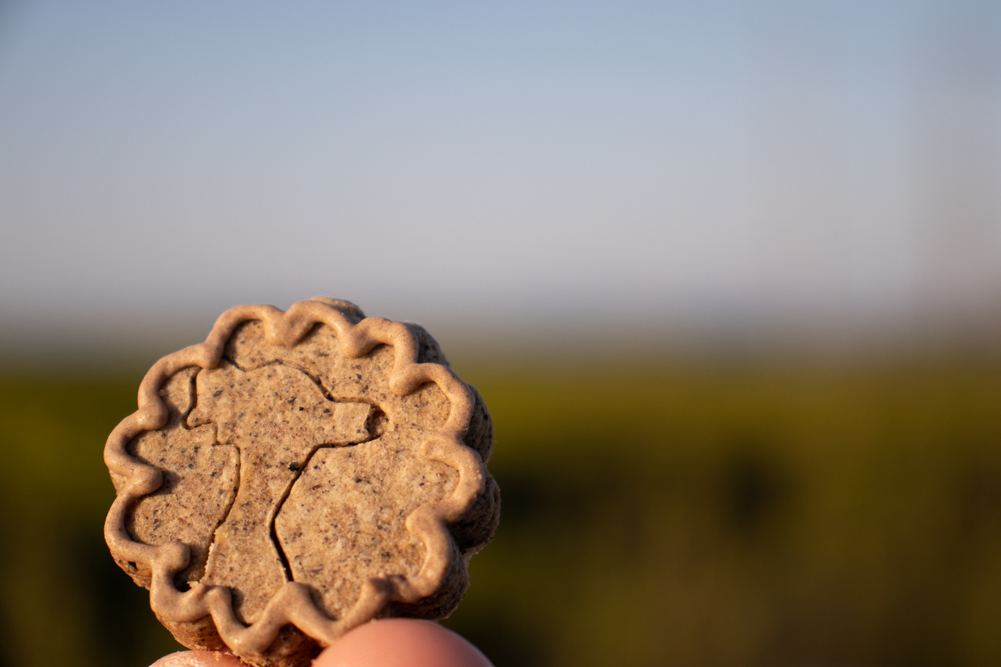 ▲Seasonal black tea cookies are also offered at Daichi no Chanoma, using Kamairicha Shibamoto’s own black tea. The goat symbol embossed on the cookies is adorable.
▲Seasonal black tea cookies are also offered at Daichi no Chanoma, using Kamairicha Shibamoto’s own black tea. The goat symbol embossed on the cookies is adorable.
An art piece created by great natural forces. The time-line of a tea plantation returning to nature.
(On the way back from the Daichi no Chanoma, Shibamoto stopped to point out a corner of a tea plantation. Looking out at the view ahead, we talked about his thoughts and vision for the future of promoting tea around the world. )
‘This view is my favorite. You can see the tea fields shaped into rows by human hands, gradually returning to nature in chronological order. On the upper left is a tea field that has been recently pruned and is in a beautiful state, and just below it is a tea field that has been abandoned for two years. On the right, it has started returning to forest after about 10 years.
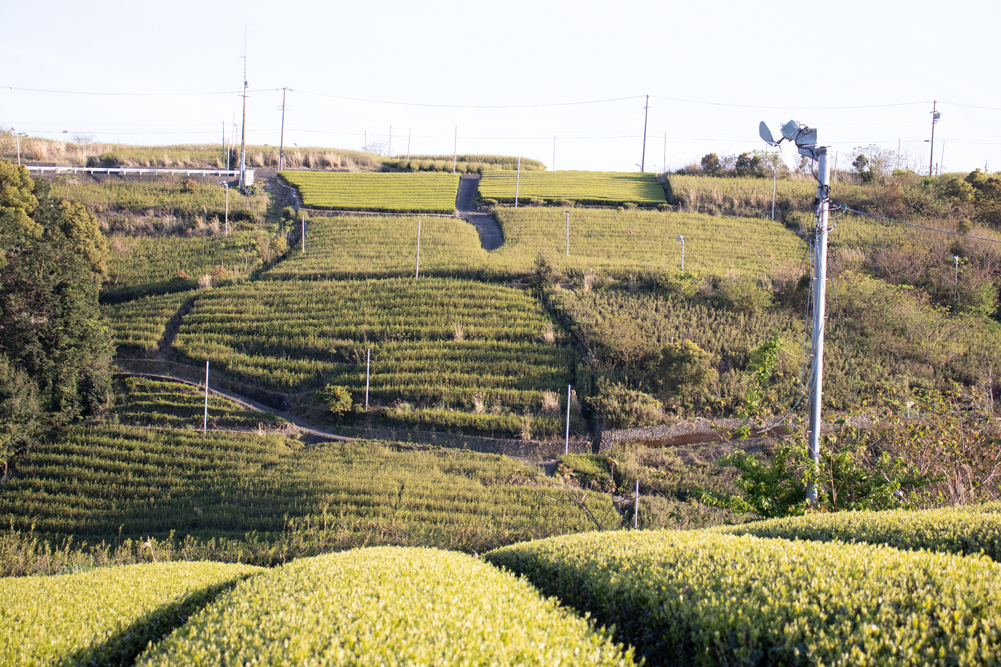 ▲This view can be seen on the road to Daichi no Chanoma.
▲This view can be seen on the road to Daichi no Chanoma.
–You’re right, that is definitely a sight to see. To be honest, I didn’t notice it on the way up here.
A scene created over many years through human activity and the life force of nature. It is not something that can be created intentionally. I think it is a work of art. To some people, however, it may seem to be nothing more than an abandoned tea plantation.
–Years ago, that whole slope would have been covered in tea fields, right?
Tea farmers in this area are rapidly going out of business. In order to stop this trend, we must continue to promote tea to the general public. We need contact points for people to get familiar with tea again. We also need people who can explain the techniques and production methods in an interesting and logical way.
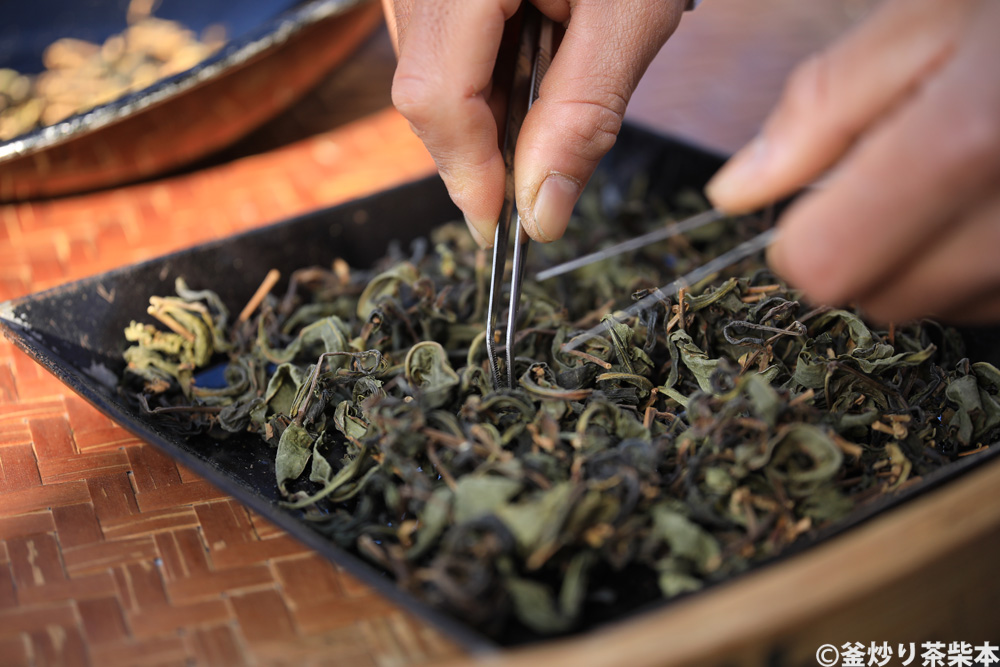
–Aren’t techniques and production methods supposed to be closely guarded industrial secrets?
There may be a handful of people who do not like the idea of teaching techniques and production methods. However, the number of people who are interested in tea, want to learn more about it, and want to make tea themselves is steadily increasing.
I want to be a tea master and artist who is able to respond to such desires. More than anything, I would be most pleased if I could increase the number of comrades and friends who will spread the word about tea (laughs).
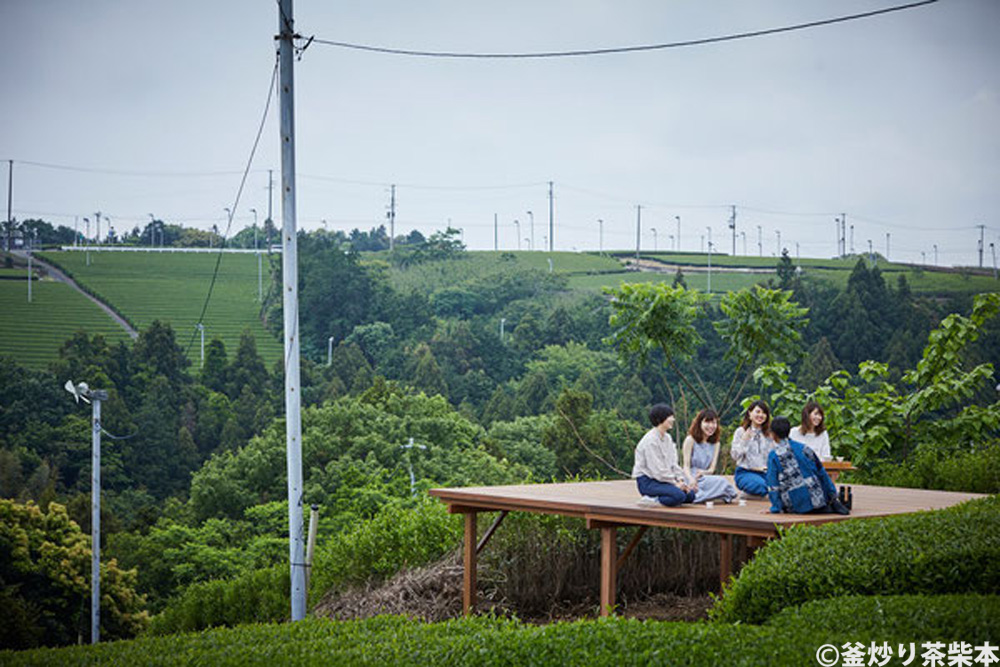
Related articles :The world of aromatic matured teas invited by Kamairicha Shibamoto【Kamairicha, Shizuoka Prefecture】
Related articles :Here at ‘Chanoma’ (Space for Tea) in Fuji city, Shizuoka one may experience the mysterious atmosphere of a tea garden.【Fuji city,Shizuoka Prefecture】
Information of Daichi no Chanoma
| Address | 2695 Katsumata, Makinohara, Shizuoka 421-0414, Japan |
| Website | https://changetea.jp/en/chanoma/daichi-chanoma/ |
| Phone number | 080-5295-7196 |
| E-money and credit cards | Partially e-money available |
| Open | 10:00~17:00 (Subject to change depending on the time of year) |
| Closed | non-scheduled holiday |
| Parking lot | A small number of parking spaces are available. |
| Access | 20 minutes by car from Tomei Sagara Makinohara IC, 10 minutes walk from Shibamoto-san’s house, the reception area, to the teahouse. |
| Writer | Norikazu Iwamoto |
| Career | Ochatimes chief editer. Meeting with Vice Governor of Shizuoka prefecture. Judge of Shizuoka 100 tea’s award in 2021~23. Ocha Times link introduced at website of World O-CHA(Tea) Festival 2022, Tea Science Center, The City of Green Tea Shizuoka, Ministry of Agriculture, Forestry and Fisheries. |
| English translator | Calfo Joshua |
| Career | Born and raised in England, living in Japan since 2016. Studying arboriculture in Shizuoka Prefecture whilst operating his landscape business Calfo Forestry. Appreciating the nature of Japan and the culture that places such importance in it. |


 Go to Japanese page
Go to Japanese page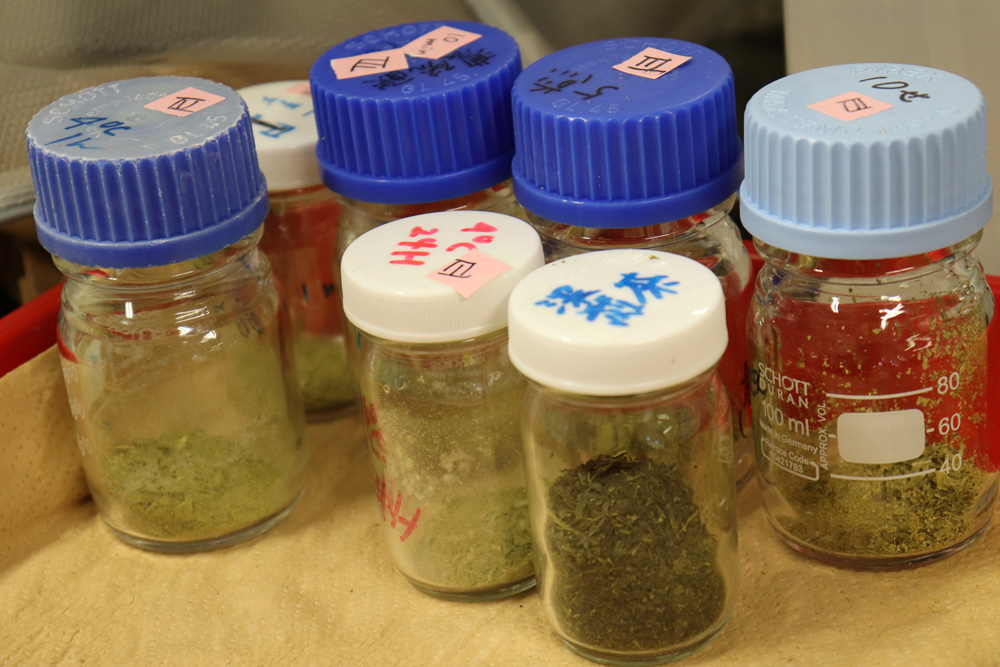
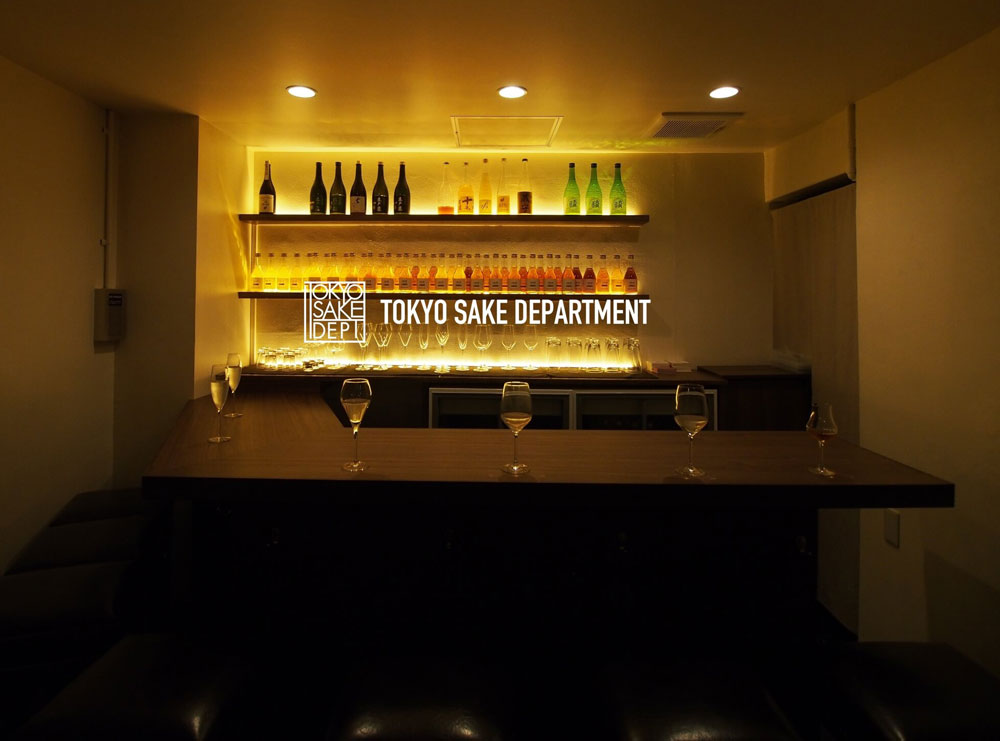
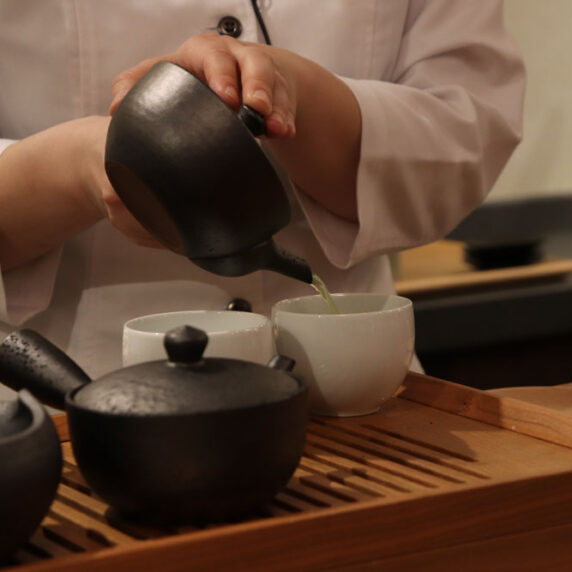
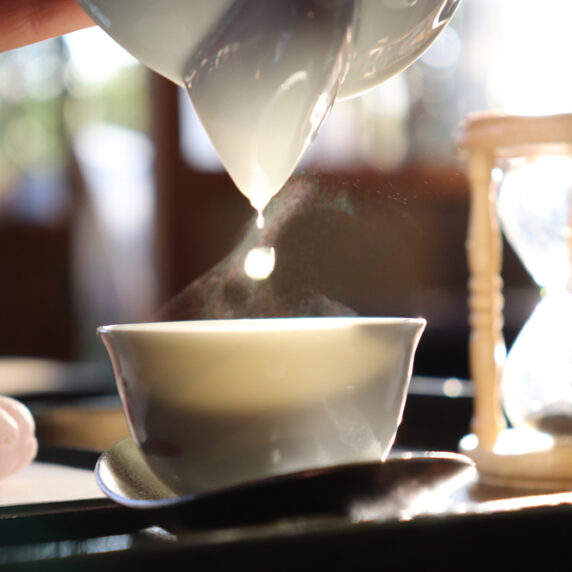
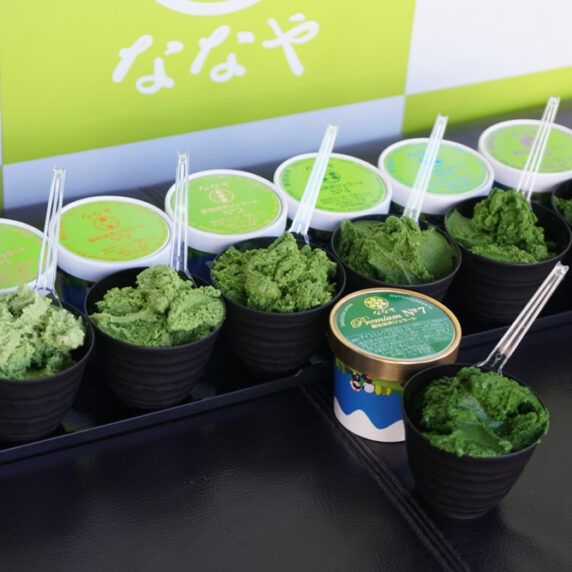
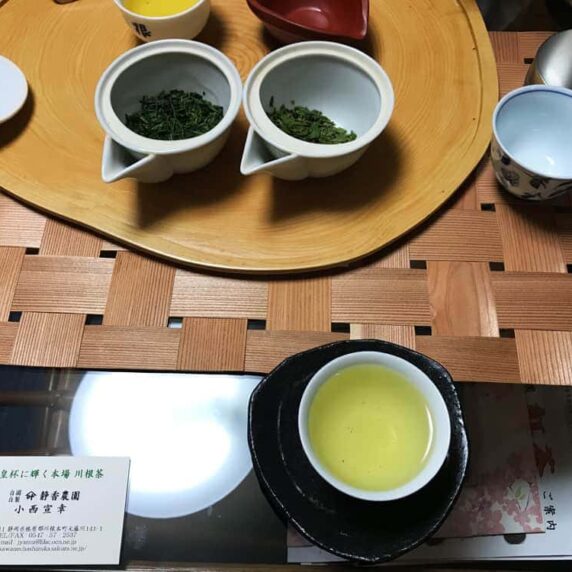
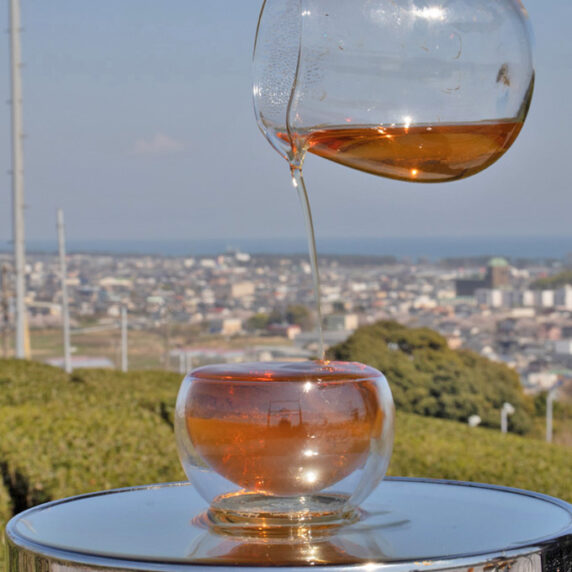




 on the red bar to close the slide.
on the red bar to close the slide. to see the distance between the current location to the Chaya.
to see the distance between the current location to the Chaya.